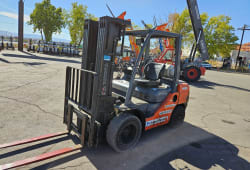Quick Guide: Forklift Performance
7 Min read
)
May 5, 2023
Warehouses and distribution centers are vital parts of the supply chain and they require the right tools to ensure efficient operations. Forklifts are essential pieces of equipment for warehouse and distribution centers and they come with a variety of benefits that make them worth the investment. In this blog post, we will discuss the benefits of forklifts for warehouses and distribution centres.
Increased Efficiency
Forklifts can help to increase the efficiency of warehouses and distribution centres. They can be used to quickly and easily lift trucks and move large amounts of product from one location to another, allowing operations to take place faster and more efficiently. They can also be used to lift and move heavy items, which can help to reduce the risk of injuries from manual lifting and carrying. This can help to reduce the amount of time needed to complete tasks, as well as occupational safety and health as reduce the risk of accidents.
In addition to the benefits mentioned above, forklifts can also help to increase the overall efficiency of a warehouse or distribution centre by enabling workers to move products around more quickly and efficiently. With the help of a forklift, workers can easily move multiple pallets of products at the same time, which can significantly reduce the number of trips required to transport products from one location to another. This can save a considerable amount of time and increase the throughput of the entire operation.
Furthermore, forklifts can be equipped with various attachments such as clamps, rotators, and side shifters, which can further enhance forklift certification and efficiency. Clamps can be used to hold products securely while transporting them, rotators can help to rotate products to the correct orientation, and side shifters can be used to move the forks sideways to adjust the placement of products. All of these attachments
Improved Safety
Forklifts have been designed with safety features that can help to further enhance the safety of warehouses and distribution centers. For mine safety practices for instance, some forklifts are equipped with sensors that can detect obstacles and automatically stop the forklift to avoid collisions. Additionally, some forklifts come with advanced technology such as cameras and laser sensors that give the operator a 360-degree view of their surroundings, providing improved visibility for safe operation and reducing the risk of accidents.
Operator Training
Another safety consideration for forklifts is the operator's performance and training. Employers have a responsibility to ensure that their forklift operators are properly trained, certified, and follow safe operating practices. for training methods, It is important that operators are trained on how to operate the specific type of forklift they will be using, and that they are familiar with the safety features and proper procedures for operating the equipment. Regular refresher training can also help to reinforce safe operating practices and keep operators up to date with the latest safety guidelines and regulations.
Quick Guide: Forklift Performance
Training Program
In addition to forklift safety training itself, warehouses and distribution centres need to have safety protocols in place. This can include designated areas for forklift operation, clear signage indicating pedestrian safety on walkways, and safety barriers to prevent collisions. It is also important to regularly inspect forklifts to ensure they are in good working condition and to promptly address any maintenance or repair issues that arise.
By prioritizing safety and ensuring proper operator training programs, and safety protocols for trained operators, forklifts can help to improve safety in warehouses and distribution centers, reducing the risk of accidents and injuries.
Cost Savings
Forklifts are an investment that can pay off in the long run. They can help to reduce labour costs by enabling one operator to perform tasks that might otherwise require multiple people to complete. This can result in cost savings over time, as the forklift operator can move large quantities of goods more efficiently, reducing the need for additional personnel.
Furthermore, forklifts can help to reduce the risk of injuries, which can result in lower workers' compensation costs. The use of forklifts can help to reduce the amount of manual lifting and carrying required, which can result in fewer injuries related to back pain, strains, and other physical exertions. The operator with forklift training can do safe forklift operations and lift and move heavy items with ease, reducing the risk of accidents and minimizing the risk of injury.
Improved Workplace Accuracy
In addition, forklifts can help to improve the accuracy of inventory tracking, which can lead to cost savings over time. With the help of forklifts, goods can be easily and quickly moved around the center of gravity warehouse, allowing for more efficient storage and retrieval of inventory. This can help to minimize the risk of errors in inventory tracking, reducing the need for additional labor to correct errors.
Lastly, forklifts can help to save time by reducing the amount of time needed to complete tasks. They can move goods and materials around the warehouse more quickly and efficiently than manual labor can, which can help to speed up the workflow and increase productivity. This can help to reduce labor costs and increase the efficiency of the warehouse or distribution center, resulting in significant cost savings over time.
Warehouse Use
Forklifts are highly versatile pieces of equipment that offer flexibility in warehouses and distribution centers. They can be used to move a wide variety of products, from small packages powered by industrial trucks to large, bulky items powered by industrial trucks. The forks on a forklift can be adjusted to fit different types of loads, and some models can even handle multiple pallets at once, making them efficient for moving multiple items at once. Forklifts can also be used to maneuver through tight spaces, narrow aisles, and crowded storage areas, allowing them to access and move products that would be difficult or impossible for manual laborers to reach.
Loading and Unloading
Additionally, forklifts can be used for various tasks, such as loading and unloading trucks, transporting materials between different areas of the warehouse or loading dock, and even stacking pallets in high racks. They can also be fitted with attachments such as clamps, rotators, and side shifters, which can further enhance their versatility by allowing them to handle different types of products and tasks.
Flexibility of Forklifts
The flexibility of forklifts also means that they can be used in a variety of industries beyond warehouses and distribution centres. They are commonly used in manufacturing, construction, and agriculture, among other sectors, due to their ability to handle heavy loads and manoeuvre in tight spaces.
Overall, the versatility occupational safety, and flexibility of forklifts make them a valuable investment for any business that requires efficient and safe handling of materials and products.
Putting It All Together
In conclusion, forklifts are vital pieces of equipment for warehouses and distribution centres that offer many benefits. Their increased efficiency helps to move large amounts of products quickly and easily, reducing the time required to complete tasks and increasing productivity. Furthermore, for safe truck operation, forklifts provide improved safety with operators being seated and using controls to move the forks and lift the truck, and can be fitted with safety features like rollover protection and seat belts to reduce the risk of accidents and injuries.
Moreover involved in an accident, however, the use of forklifts can lead to cost savings, including lower labor costs and workers' compensation costs, as well as higher productivity. Forklifts are also highly flexible pieces of equipment that can be used to move large amounts of product, lift and move heavy items, and transport items up and down aisles or across a warehouse.
Therefore, investing in a forklift can be a wise decision for any warehouse or distribution centre, resulting in improved operations, greater efficiency, proper safety procedures, and overall cost savings. By incorporating forklifts into the daily operations of these facilities, they can reduce risks, increase productivity, and enhance safety, ultimately leading to better performance and increased profitability.
Also Read: How to Operate a Telehandler Forklift Safely
Visit Boom & Bucket to buy and sell your machinery.
:format(webp))

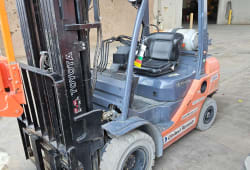
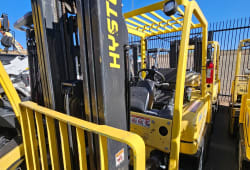
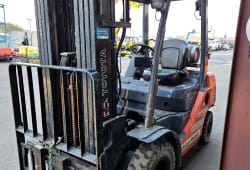

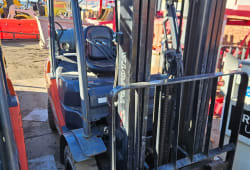


:format(webp))
